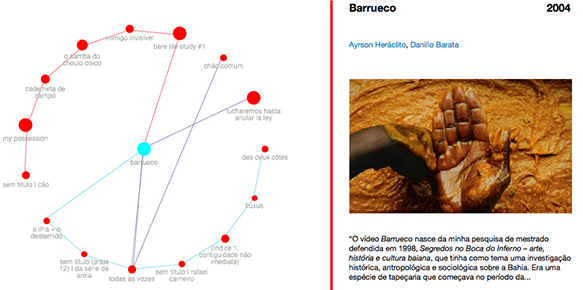Ayrson Heráclito & Danillo Barata
Ayrson Heráclito researches the heritage and the historical, cultural, social and religious influences stemming from the arrival of Africans in Brazil, particularly in the state of Bahia. In addition to addressing traditions whose origins are African, Heráclito reflects about the birth of Afro-Brazilian culture. In his videos, installations and performances, he employs emblematic materials of what he has called, in a statement to PLATFORM:VB, “Bahia’s cultural body,” one that is marked by slavery. Palm oil, sugar and beef jerky are among the elements utilized by the artist which are intimately tied to the history of slavery. In his audiovisual productions, Danillo Barata’s videos and video installations investigate the body in relation to the world and the body as bearer of history, social conventions and personal and collective memories.
The artists joined forces to create Barrueco (2004), which has been part of the Videobrasil Collection since it featured in the 15th edition of the Festival (2005). The video comprises elements riddled with references to the African continent and the memory of slavery, and its focal point is the ocean. The ocean in Barrueco is made of palm oil. J. M. W. Turner’s painting Slave Ship (1840) gradually appears and disappears. The video is punctuated by verses from Mira Albuquerque’s poem Divisor (Divider - “Ocean-like is the black solitude/Atlantic was the fear of the sea.”), to the sound of Black Is the Colour (Of My True Love’s Hair), sung by Nina Simone.
According to Gabriela Salgado, the curator who wrote an essay on the piece for the book Unerasable Memories, “the terror of the vast ocean” changed the course of history for at least nine million enslaved people. From the ocean come the pearls: the Spanish word barrueco designates the imperfect pearl. “I was interested in the idea of an impure, non-classical beauty; something complex and mixed-race, which is the Brazilian cultural phenomenon and specifically the dynamics that were established as Africans arrived,” Heráclito tells PLATFORM:VB.
Turner’s painting alludes to the episode, in 1781, when, in order to spare fresh water during the crossing of the North Atlantic, over 140 African slaves were cast into the sea by a British ship’s crew. The traditional tune Black Is the Colour (Of My True Love’s Hair) had its lyrics adapted and gained new contours in the rendition of singer and activist Nina Simone – an Afro-descendent, it is worth noting.
Finally, the oil palm tree, originally from Africa’s West Coast, was brought to Brazil in the same ships that carried people. Widely used in cuisine and in religious cults, palm oil is described by the artist, in a statement to VB Channel, as “plant’s blood, ancestral blood, the golden sperm of Exu” and sustains both objective and mythical-symbolic ties with the motherland. In the Festival’s 18th edition, Heráclito took part in the Public Programs meeting themed Magical Nature, alongside artists like Bakary Diallo (1979-2014) and Roberto Winter, with mediation from curator Pablo Lafuente. At the meeting, the artist said “this connection between art and magic has always existed, even after the world became desacralized.”
Barrueco makes evident the fact that the present is inescapably the outcome of historical processes – even those we believe we have outgrown. By employing the black body “as a vessel of knowledge and traditional wisdom, the artists display the fundamental tools of resistance and decolonization, in the midst of reigning prejudice, invisibility and oppression,” Gabriela Salgado remarks. To Heráclito, contemporary problems like poverty and discrimination are directly connected with colonial histories: “I am interested (...) in finding, in the past, the potential interpretations for contemporary times. My approach towards civil issues makes sense only as part of a dialogue with the ‘origins’ to these issues: racism, poverty, economic bankruptcy etc.,” he says in an interview published on FF>>Dossier 036.
Learn more about the artist:
- Ayrson Heráclito and Danillo Barata on Videobrasil Collection
- Barrueco on Videobrasil Collection


